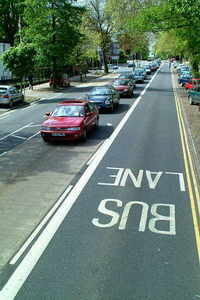 Any call to abolish bus lanes is, of course, somewhat passe, but there is still an ongoing need to question the logic behind devoting an entire carriageway of the public highway to an apunctual, inefficiently engineered, pollution-generating form of public transport.
Any call to abolish bus lanes is, of course, somewhat passe, but there is still an ongoing need to question the logic behind devoting an entire carriageway of the public highway to an apunctual, inefficiently engineered, pollution-generating form of public transport. In those places where two lanes previously existed, the introduction of a bus lane approximately halves the capacity of the road. This approximately doubles the amount of congestion and, perforce, doubles the amount of pollution.
Those who attempt to justify the imposition of bus lanes, such as Transport for London, claim that bus lanes 'encourage' people to travel by bus. In fact it is claimed, without any reference to supporting documentation, that bus usage in London is up by 40% in the last 5 years. However, even if this were true, and even if this were attributable to the imposition of bus lanes, it doesn't follow that congestion will decrease as a consequence. If the capacity of a road has been halved, then approximately half of all road-users will need to travel by bus to restore the level of congestion to even its pre-existing level. And there simply aren't a sufficient number of buses for that to happen.
So the net result, then, is more congestion, more pollution, more frustration, and fractionally shorter bus journeys. Does this represent a net gain? I'm not sure that it does.

4 comments:
You would think this is a no-brainer: a defence of free traffic deployment against Public Transport bullies.
There are, it is true, still 2,500 golf courses in Britain covering half a million acres, but it has to be said that there are also, at present, 1,2 billion trucks, buses and cars which, by the year 2020 will stretch 120 times around the planet earth. And it is here that we reach the crucial point of the public transport conundrum, with the realization of the fact namely that the conveying structure is hopelessly condemned. And you, Sir, are relying for its future assessment on parochial intellectual processes rather than the rational acknowledgment of an insurmountable barrier by a physical cause
Men are unbelievable. More like pre-pubescent boys. If all buses were made to look like inflatable dolls they’d be much more likely to enter them...
Dreamy
My argument wasn't an argument in support of unconstrained traffic flow, merely an argument against bus-lanes (and implicitly against buses as an urban traffic solution). Amsterdam should be the template for any modern city-centre: widespread pedestrianisation, in conjunction with a ubiquitous tram-system. Buses and bus-lanes are an anti-solution.
I listened to a debate on the radio on tansport solutions before Christmas. As with all radio debates, there were hundreds of people who thought that their experience of one bus route, train journey or even the current traffic jam on one road was a valid argument for nationwide changes in policy.
But the "expert" in this debate was a planner, who was very convincing. He said that in terms of cost analysis and actual traffic information, an assessment can be made about the best transport infrastructure to build in a certain situation. So with cities of a certain size and population density etc, they can decide whether to provide buses, bus routes, provide entire roads except for buses and taxis, provide trams or, as the last measure, an underground system. He was unable to explain the algorithms and go into a detailed discussion of it all within the scope of the debate, but he was convincing enough that I now actually trust transport planners to get on with it. After all, it's not an easy job and while they don't get everything right, I can't imagine I'd do it any better
Just found this post. One thing people get wrong is that reducing from 2 lanes to 1 lane does NOT "reduce the capacity by approximately one half". In fact, a single lane has approximately twice the capacity for moving traffic as a lane in a multi-lane configuration, because people have to drive further from each other in a multi-lane situation. Vehicles spread out like a gas, not like a liquid as you imply. Single lanes can have very high capacities, especially in lightly signalized areas.
Post a Comment